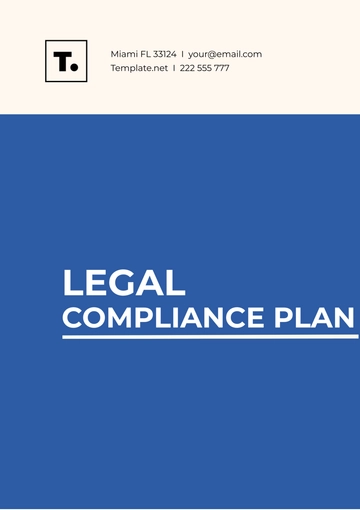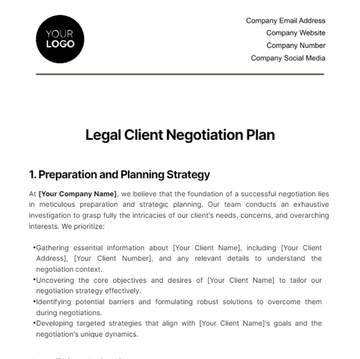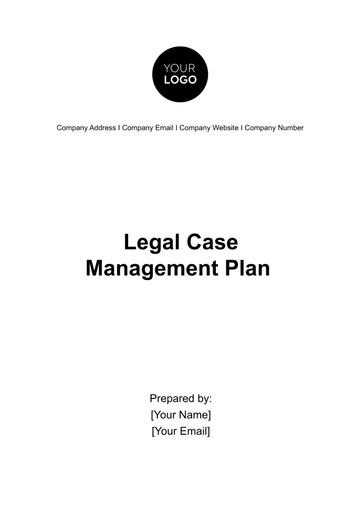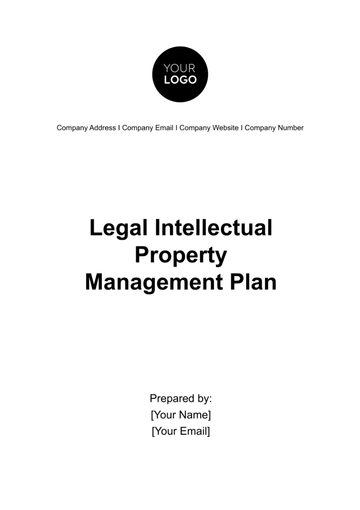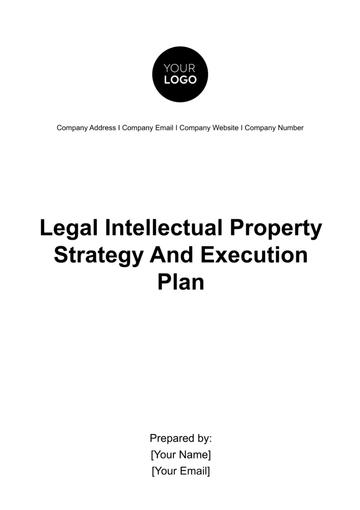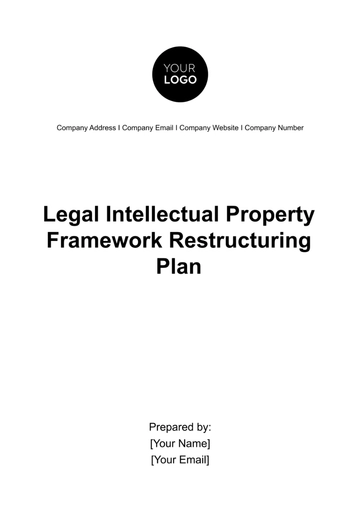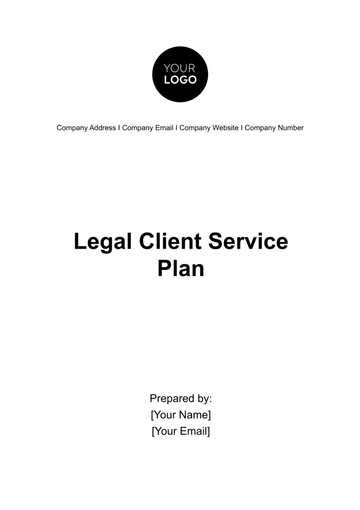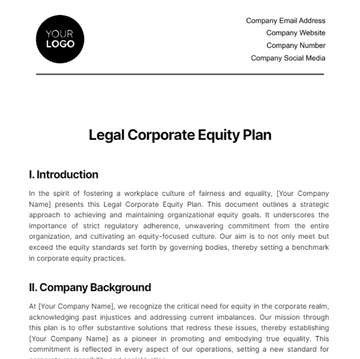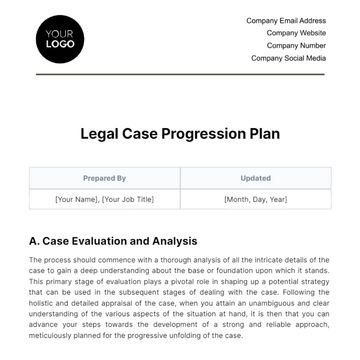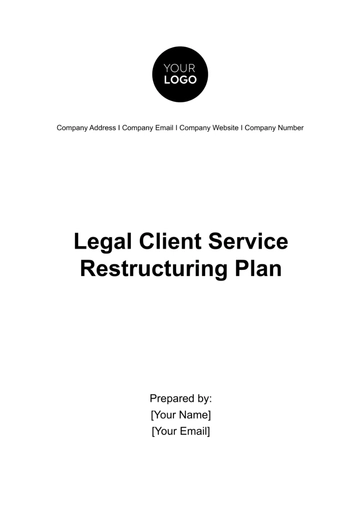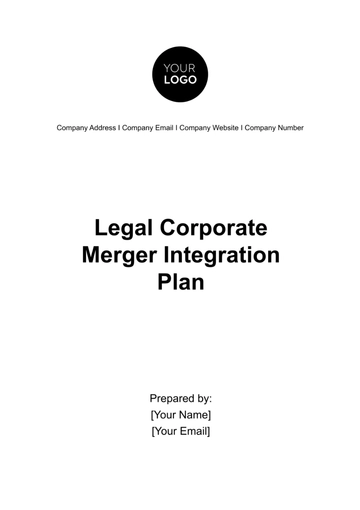Free Legal Corporate Merger Integration Plan
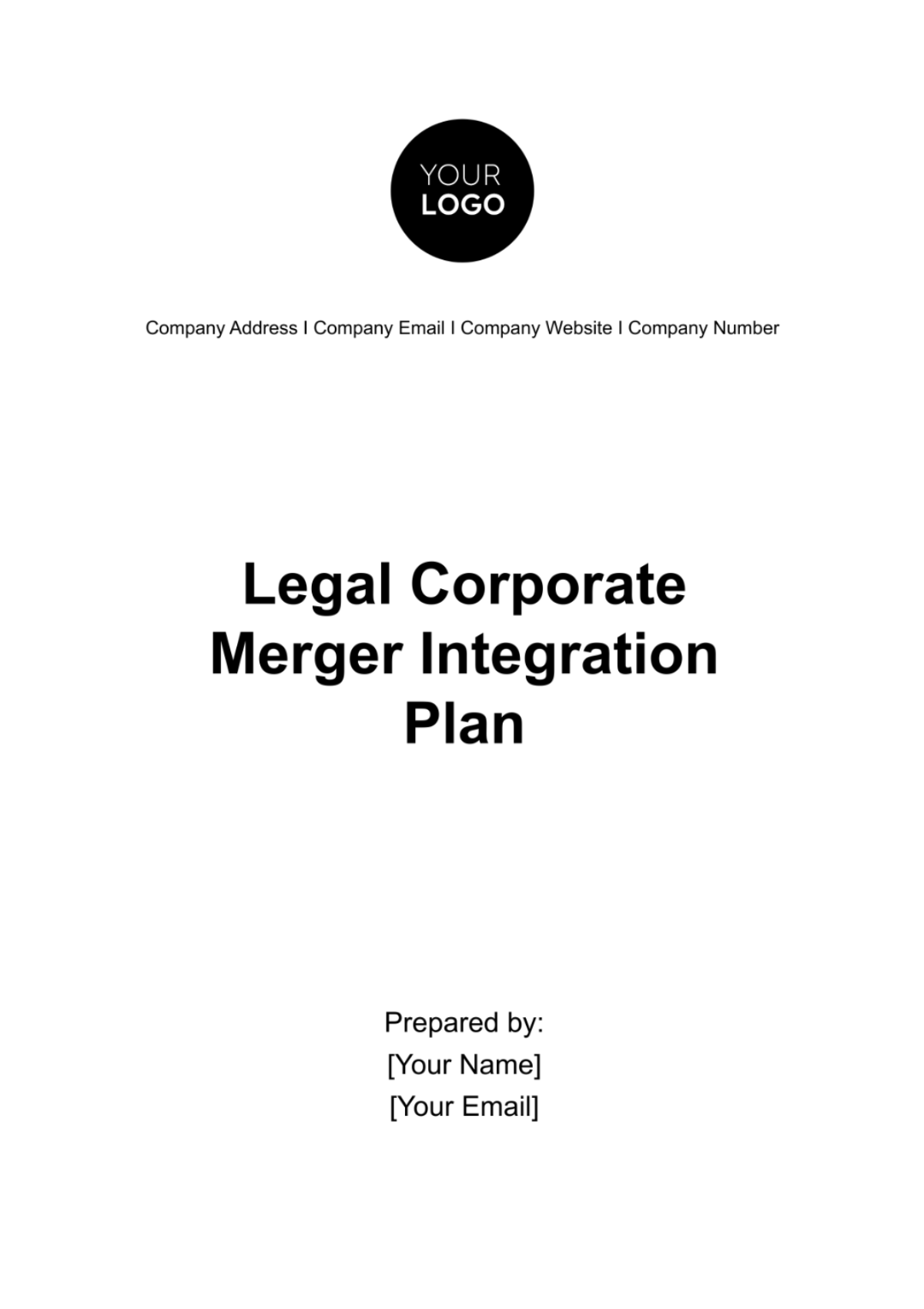
I. Introduction
Overview
The merger between [Your Company Name] and [Your Partner Company Name / Second Party] marks a significant milestone in the consolidation of complementary strengths and resources to create a stronger, more competitive entity in the market. By combining expertise, customer bases, and product portfolios, the merged company aims to enhance value proposition and drive sustainable growth. This integration plan serves as a roadmap for aligning operations, processes, and people to achieve synergies and maximize shareholder value.
Purpose and Objectives
This integration plan is designed to achieve several key objectives, including ensuring a seamless transition for employees and customers, optimizing operational efficiencies, and realizing cost synergies. Additionally, the plan aims to maintain regulatory compliance, protect intellectual property assets, and foster a cohesive corporate culture. By adhering to these objectives, the merged entity can position itself as a market leader and capitalize on new growth opportunities.
Key Stakeholders
Stakeholder | Role |
|---|---|
Integration Steering Committee | Provide strategic direction and oversight |
Integration Workstreams | Execute integration activities across functional areas |
Employees | Implement changes and support integration efforts |
Customers | Experience minimal disruption in service and support |
Shareholders | Realize value creation and growth potential |
II. Legal and Regulatory Compliance
Regulatory Approvals and Filings
The team responsible for integration will work cooperatively with the legal counsel. Their joint efforts will focus on preparing and submitting paperwork relating to regulatory compliance. This paperwork will be submitted to various governmental agencies and other bodies that execute regulatory oversight. Their approval is essential for our integration efforts to move forward. Careful attention would be paid to timelines associated with both the submission and approval processes. The team will strive to ensure strict compliance is adhered to with regard to all regulatory requirements. This measure is integral to preventing any potential delays that might hinder the overall integration process. Any such delay could create unforeseen complications, making this a priority for the team. They understand, and are prepared to navigate regulatory boundaries as they progress through the integration process.
Intellectual Property Rights Assessment and Protection
We will conduct a comprehensive and meticulous review of all intellectual property assets with the intention of identifying any possible risks or conflicts that may exist. Our ultimate goal is to establish and deploy effective and robust strategies that ensure maximum protection of these intellectual property assets. To ensure comprehensive protection, our review will cover various facets of intellectual property including patents, trademarks, copyrights as well as trade secrets. This will involve careful evaluation to ensure that all necessary documents are in place, all mandatory registrations have been completed, and all proper enforcement measures are in operation for them.
Contract Review and Assignment
To ensure the thoroughness and accuracy of the merger process, an exhaustive review will be carried out on all contracts and agreements associated with both companies. This thorough review will involve the identification of the various elements and provisions within these contracts and agreements, which include the obligations of the involved parties, their respective rights, and also the termination clauses. To facilitate continuity in business relations following the merger, and to effectively mitigate any legal risks that may arise, legal counsel will oversee the process. They will ensure that the necessary legal actions, like the assignment or novation of contracts, are executed appropriately in accordance to the demands of the situation.
III. Financial Integration
Consolidation of Financial Statements and Reporting
The financial statements of the soon-to-be merged entity will undergo a process of consolidation. This process will strictly abide by the Generally Accepted Accounting Principles, commonly known as the GAAP. The chief reason behind this adherence is to deliver a presentation of the entity's financial position that is both transparent and accurate. Alongside the task of consolidation, there is an imperative for the organization's finance team to collaborate with external auditors. Their role in this collaboration is to ensure that all the reporting standards are thoroughly complied with. Should there be any discrepancies or material issues that come to light during this process, the finance team will take full responsibility for addressing them in order to maintain the highest standards of financial transparency and accuracy.
Tax Considerations and Optimization Strategies
The tax ramifications of the impending merger will undergo a detailed evaluation, primarily to ensure maximum tax efficiency while simultaneously minimizing potential liabilities. This inclusive evaluation will involve an in-depth study of several aspects of taxation. Components such as corporate taxation, income tax, and various indirect taxes will be thoroughly analyzed. The ultimate aim of this analytical phase is to uncover any opportunities that can be beneficial from a tax planning perspective, and to optimize tax outcomes. While focusing on these advantages, we must also make certain that we adhere strictly to the prevailing tax laws and regulations. We cannot bypass or ignore this requirement, as compliance with legal provisions regarding taxation is of equal, if not more, significance than tax optimization and planning.
Evaluation of Accounting Policies and Practices
A comprehensive evaluation will be carried out in the realm of accounting policies and practices with the primary aim being to pinpoint areas where there is both alignment and a divergence. After the completion of an in-depth assessment, the finance team will be in charge of formulating a unity-focused set of accounting policies. The purpose of this harmonized set of policies is to guarantee that there is consistency and comparability when it comes to financial reporting. Attention will also be given to industry standards and best practices to ensure that the accounting policies created are in line with the most effective and efficient strategies and methodologies in the field.
IV. Operational Integration
Alignment of Business Processes and Workflows
Business processes and workflows will be reviewed and standardized to eliminate redundancies and streamline operations. This includes mapping out current processes, identifying inefficiencies, and implementing standardized procedures to improve productivity and efficiency.
Evaluation of Supply Chain and Logistics
The supply chain and logistics operations will be assessed to identify opportunities for optimization and cost savings. This includes analyzing supplier relationships, distribution networks, and inventory management practices to streamline processes and improve responsiveness to customer demand.
Integration of IT Systems and Infrastructure
IT systems and infrastructure will be integrated to facilitate seamless communication and data sharing. This includes migrating data, applications, and platforms to a unified IT architecture, ensuring compatibility, reliability, and scalability while minimizing disruption to business operations.
V. Human Resources Integration
Workforce Assessment and Talent Retention Strategies
A comprehensive assessment of the workforce will be conducted to identify key talent and critical skills. The HR team will develop retention strategies, including competitive compensation, career development opportunities, and employee engagement initiatives, to retain top performers post-merger.
Harmonization of Compensation and Benefits
Compensation and benefits packages will be harmonized to ensure fairness and equity across the merged entity. This includes reviewing salary structures, incentive plans, and employee benefits to develop a unified compensation and benefits framework that aligns with market practices and business objectives.
Cultural Integration Initiatives
Cultural integration activities will be implemented to foster a unified corporate culture and values. This includes promoting open communication, collaboration, and teamwork to build trust and mutual respect among employees from both companies.
Employee Communication and Engagement
Transparent and timely communication will be prioritized throughout the integration process. This includes providing regular updates, addressing employee concerns, and soliciting feedback to ensure that employees feel informed and engaged in the integration process.
VI. Communication Plan
Stakeholder Communication Strategy
A comprehensive communication strategy will be developed to keep stakeholders informed about the merger and integration process. This includes identifying key messages, channels, and audiences, and tailoring communication to meet their needs and expectations.
Internal and External Communication Protocols
Protocols for internal and external communication will be established to ensure consistency, accuracy, and confidentiality. This includes defining roles and responsibilities, approval processes, and channels of communication to facilitate effective communication across the organization.
Crisis Communication Plan
A crisis communication plan will be developed to address potential issues or challenges that may arise during the integration process. This includes identifying potential risks, developing response strategies, and establishing communication protocols to ensure timely and accurate information dissemination in case of emergencies or crises.
Branding and Messaging Alignment
Branding and messaging will be aligned to reflect the merged entity's identity and value proposition. This includes developing branding guidelines, messaging frameworks, and communication materials to ensure consistency in visual identity, tone of voice, and brand positioning across all communication channels.
VII. Risk Management
Identification of Integration Risks and Challenges
Potential risks and challenges associated with the merger and integration will be identified and assessed. This includes conducting risk workshops, scenario analyses, and risk assessments to prioritize risks and develop mitigation strategies.
Risk Mitigation Strategies and Contingency Plans
Mitigation strategies will be implemented to address identified risks and minimize their impact on the integration process. This includes developing contingency plans, alternative courses of action, and response protocols to ensure timely and effective risk management.
Insurance Coverage Review
Existing insurance policies will be reviewed to assess coverage adequacy and identify gaps. This includes working with insurance brokers to secure appropriate insurance coverage for the merged entity, including coverage for key personnel, property, liability, and business interruption.
Legal Dispute Resolution Mechanisms
Legal dispute resolution mechanisms will be established to address conflicts or disputes that may arise during the integration process. This includes developing procedures for resolving disputes through negotiation, mediation, arbitration, or litigation, as appropriate, to protect the merged entity's interests and preserve business relationships.
VIII. Timeline and Milestones
Phased Approach to Integration Activities
Integration activities will be organized into distinct phases to facilitate planning, execution, and monitoring. This includes defining clear objectives, deliverables, and timelines for each phase to ensure progress tracking and alignment with overall integration goals.
Key Milestones and Deadlines
Key milestones and deadlines will be established to track progress and measure success. This includes prioritizing critical activities and setting realistic timelines for completion, taking into account dependencies, resource availability, and potential risks.
Resource Allocation and Dependencies
Resources, including personnel, budget, and technology, will be allocated strategically to support integration activities. This includes identifying resource requirements, dependencies, and constraints to optimize resource utilization and minimize bottlenecks.
Progress Tracking and Reporting Mechanisms
Progress tracking and reporting mechanisms will be implemented to monitor the status of integration activities and milestones. This includes developing dashboards, KPIs, and progress reports to provide visibility into performance and facilitate decision-making by senior management.
IX. Governance Structure
Integration Management Team Roles and Responsibilities
The integration management team will comprise representatives from [Your Company Name] and [Your Partner Company Name / Second Party], including executives, project managers, and functional leads. Roles and responsibilities will be clearly defined to ensure accountability and coordination across workstreams.
Decision-Making Processes and Escalation Procedures
Decision-making processes and escalation procedures will be established to resolve issues and make timely decisions. This includes defining decision criteria, authority levels, and escalation paths to address conflicts or unresolved issues effectively.
Cross-Functional Coordination Mechanisms
Cross-functional coordination mechanisms will be implemented to facilitate collaboration and communication across workstreams. This includes holding regular meetings, workshops, and status updates to share information, align priorities, and address interdependencies.
Integration Governance Framework
An integration governance framework will be established to provide oversight and guidance throughout the integration process. This includes defining the roles and responsibilities of the integration steering committee, workstream leads, and other stakeholders to ensure alignment with business objectives and adherence to integration timelines.
X. Technology Integration
Assessment of IT Infrastructure and Systems Compatibility
An assessment of IT infrastructure and systems will be conducted to identify compatibility issues and integration requirements. This includes evaluating hardware, software, networks, and data centers to develop a plan for integrating IT systems and infrastructure.
Data Migration and Integration Strategies
Data migration and integration strategies will be developed to transfer data seamlessly between systems and ensure data consistency and integrity. This includes prioritizing data migration activities based on business criticality, complexity, and risk, and implementing data validation and quality control measures to minimize errors and discrepancies.
Cybersecurity and Data Privacy Considerations
Cybersecurity and data privacy considerations will be integrated into IT systems and infrastructure to protect sensitive information and mitigate security risks. This includes implementing security controls, encryption protocols, and access management policies to safeguard data assets and comply with regulatory requirements.
IT Support and Training for Employees
IT support and training programs will be provided to employees to familiarize them with new systems and technologies. This includes developing training materials, user guides, and FAQs to help employees navigate IT systems and troubleshoot common issues, ensuring a smooth transition and minimizing productivity disruptions.
XI. Cultural Integration
Assessment of Organizational Cultures and Values
An assessment of organizational cultures and values will be conducted to identify similarities, differences, and potential areas of alignment. This includes gathering feedback through surveys, interviews, and focus groups to understand employee perceptions and preferences.
Integration of Corporate Cultures and Employee Engagement Initiatives
Corporate cultures will be integrated through employee engagement initiatives, including team-building activities, social events, and cultural awareness programs. This includes promoting open communication, collaboration, and teamwork to build trust and mutual respect among employees from both companies.
Leadership Development and Change Management
Leadership development and change management programs will be implemented to support employees through the integration process. This includes providing leadership training, coaching, and mentoring to empower managers and executives to lead by example, inspire confidence, and drive organizational change effectively.
Employee Feedback Mechanisms
Employee feedback mechanisms will be established to solicit input, address concerns, and recognize achievements. This includes creating channels for feedback, such as suggestion boxes, town hall meetings, and online forums, to encourage open dialogue and continuous improvement, fostering a culture of transparency, trust, and accountability.
XII. Conclusion
Summary of Key Integration Priorities and Actions
This Legal Corporate Merger Integration Plan outlines the key priorities, actions, and timelines for integrating [Your Company Name] and [Your Partner Company Name / Second Party]. By implementing the strategies outlined in this plan, we aim to achieve a seamless transition, maximize value creation, and position the merged entity for long-term success in the marketplace.
Next Steps and Implementation Timeline
The integration team will execute the integration plan according to the timelines and milestones established in this document. Regular progress updates and status reports will be provided to stakeholders to ensure alignment with objectives and facilitate informed decision-making.
Continuous Improvement and Monitoring Strategies
Continuous improvement and monitoring strategies will be implemented to evaluate the effectiveness of integration activities and identify opportunities for optimization. This includes conducting post-merger reviews, lessons learned sessions, and performance evaluations to refine processes, address issues, and drive continuous improvement across the organization.
- 100% Customizable, free editor
- Access 1 Million+ Templates, photo’s & graphics
- Download or share as a template
- Click and replace photos, graphics, text, backgrounds
- Resize, crop, AI write & more
- Access advanced editor
Discover the ultimate solution for seamless corporate mergers with our Legal Corporate Merger Integration Plan Template on Template.net. This editable and customizable template, powered by our AI Editor Tool, streamlines integration efforts, ensuring compliance, financial alignment, and cultural cohesion. Transform complexity into clarity and synergy with our comprehensive template, designed to elevate your merger process effortlessly.
You may also like
- Finance Plan
- Construction Plan
- Sales Plan
- Development Plan
- Career Plan
- Budget Plan
- HR Plan
- Education Plan
- Transition Plan
- Work Plan
- Training Plan
- Communication Plan
- Operation Plan
- Health And Safety Plan
- Strategy Plan
- Professional Development Plan
- Advertising Plan
- Risk Management Plan
- Restaurant Plan
- School Plan
- Nursing Home Patient Care Plan
- Nursing Care Plan
- Plan Event
- Startup Plan
- Social Media Plan
- Staffing Plan
- Annual Plan
- Content Plan
- Payment Plan
- Implementation Plan
- Hotel Plan
- Workout Plan
- Accounting Plan
- Campaign Plan
- Essay Plan
- 30 60 90 Day Plan
- Research Plan
- Recruitment Plan
- 90 Day Plan
- Quarterly Plan
- Emergency Plan
- 5 Year Plan
- Gym Plan
- Personal Plan
- IT and Software Plan
- Treatment Plan
- Real Estate Plan
- Law Firm Plan
- Healthcare Plan
- Improvement Plan
- Media Plan
- 5 Year Business Plan
- Learning Plan
- Marketing Campaign Plan
- Travel Agency Plan
- Cleaning Services Plan
- Interior Design Plan
- Performance Plan
- PR Plan
- Birth Plan
- Life Plan
- SEO Plan
- Disaster Recovery Plan
- Continuity Plan
- Launch Plan
- Legal Plan
- Behavior Plan
- Performance Improvement Plan
- Salon Plan
- Security Plan
- Security Management Plan
- Employee Development Plan
- Quality Plan
- Service Improvement Plan
- Growth Plan
- Incident Response Plan
- Basketball Plan
- Emergency Action Plan
- Product Launch Plan
- Spa Plan
- Employee Training Plan
- Data Analysis Plan
- Employee Action Plan
- Territory Plan
- Audit Plan
- Classroom Plan
- Activity Plan
- Parenting Plan
- Care Plan
- Project Execution Plan
- Exercise Plan
- Internship Plan
- Software Development Plan
- Continuous Improvement Plan
- Leave Plan
- 90 Day Sales Plan
- Advertising Agency Plan
- Employee Transition Plan
- Smart Action Plan
- Workplace Safety Plan
- Behavior Change Plan
- Contingency Plan
- Continuity of Operations Plan
- Health Plan
- Quality Control Plan
- Self Plan
- Sports Development Plan
- Change Management Plan
- Ecommerce Plan
- Personal Financial Plan
- Process Improvement Plan
- 30-60-90 Day Sales Plan
- Crisis Management Plan
- Engagement Plan
- Execution Plan
- Pandemic Plan
- Quality Assurance Plan
- Service Continuity Plan
- Agile Project Plan
- Fundraising Plan
- Job Transition Plan
- Asset Maintenance Plan
- Maintenance Plan
- Software Test Plan
- Staff Training and Development Plan
- 3 Year Plan
- Brand Activation Plan
- Release Plan
- Resource Plan
- Risk Mitigation Plan
- Teacher Plan
- 30 60 90 Day Plan for New Manager
- Food Safety Plan
- Food Truck Plan
- Hiring Plan
- Quality Management Plan
- Wellness Plan
- Behavior Intervention Plan
- Bonus Plan
- Investment Plan
- Maternity Leave Plan
- Pandemic Response Plan
- Succession Planning
- Coaching Plan
- Configuration Management Plan
- Remote Work Plan
- Self Care Plan
- Teaching Plan
- 100-Day Plan
- HACCP Plan
- Student Plan
- Sustainability Plan
- 30 60 90 Day Plan for Interview
- Access Plan
- Site Specific Safety Plan


